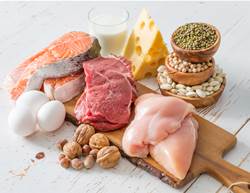1. Don’t just cut the meat
Going vegan isn’t just about cutting out animal proteins. Doing this and not replacing them will leave you feeling unsatisfied and lacking in important nutrients such as iron, zinc and protein. It’s important to replace animal proteins with good sources of plant protein including legumes (e.g. lentils, chickpeas or kidney beans) and soy products such as tofu and tempeh.
2. Prepare for when you're eating out
One of the hardest parts of switching to a vegan or plant-based diet is eating out. The great news is that many popular takeaway options are developing delicious vegan-friendly menu offerings that tick all the healthy boxes we're after.
When eating out, go for cuisines that have plenty of vegan options like Indian for the veggie-packed curries, Mediterranean for the luscious salads (hold the cheese) or why not try Mad Mex Fresh Mexican on Meat-free Monday’s and get $2 off their tasty new protein-packed plant-based Baja BBQ Vegan Chicken? It has the texture and taste of chicken but is completely vegan and gluten-free friendly. Make it up into a Naked Burrito Bowl or add it to your tacos. Being prepared and choosing what you're going to eat before you head out will ensure you leave full-bellied and satisfied with your new vegan diet.
2. Re-work your favourite meals
The best place to start is to make a meat-free version of your favourite meals. If you enjoy an Asian stir-fry you can replace the meat component of your dish with tofu. For Mexican wraps or tacos, substitute the mince for red or black beans or a plant-based meat substitute. On the BBQ you can substitute burgers for veggie patties or vegan sausages, or even try kebabs with marinated tofu and veggies. Indian curries made with lentils or chickpeas make a tasty alternative to meat-based curries. Going for Italian? Try lentil bolognese rather than your regular mince-meat spag bol. The options are endless!
3.Crowd out your meals with extra nutrients
Meat can commonly become the dominant feature in meals, so when it’s taken out, it’s essential that you fill your plate with plenty of nutrient-dense ingredients. The best way to get all the nutrients you need and to feel satisfied with meat-free meals is to balance your plate with a combination of vegetables or salads, whole grains and plant protein (such as legumes, tofu or tempeh) plus a small amount of healthy fats from foods like nuts, seeds, avocado, nut butter or tahini. When in doubt, aim for at least 3-5 different coloured ingredients on your plate.
5. Get inspired
In the beginning, it can be more difficult to think of ideas for tasty vegetarian meals. You can make this easier by finding some good cookbooks or online recipe sites to provide ideas and inspiration. With the increase in plant-based eating, there are plenty of options available! Having a variety of tasty plant-based meals is the key to making the transition to a meat-free diet sustainable. Instagram has become a treasure trove for mouth-watering vegan recipes.
Remember, when it comes to going vegan, it’s much easier to make changes to your eating if you have the support and encouragement of others around you. If friends or family members don’t want to join you, consider finding support through an online community or following qualified dietitians and nutritionists on social media who have a plant-based focus. If you are making the change for health reasons or need more individualised advice and support to make sure you are meeting your nutritional needs, consider seeing a dietitian who can support you.
Prevention is a supporter of Meat-Free Monday's and convenience food brands like Mad Mex offering plant-based alternatives for when you're on the go. Find your nearest location here.










